Recent Advances in Ni-Based Catalysts for CH4-CO2 Reforming (2013–2023)
Abstract
:1. Introduction
2. Thermodynamic Study of DRM Reactions
3. CH4-CO2 Reforming Reactions and Deactivation Mechanisms
3.1. Reaction Mechanism
3.2. Inactivation Mechanism
4. DRM Reaction Kinetics Study
5. Effect of Parameters on Catalyst Performance
5.1. Effect of Supports on Ni-Based Catalysts
5.2. Effect of Additives on Ni-Based Catalysts
5.3. Effect of Active Components on Ni-Based Catalysts
5.4. Effect of Preparation Method on Ni-Based Catalysts
6. Summary and Outlook
Author Contributions
Funding
Institutional Review Board Statement
Informed Consent Statement
Data Availability Statement
Conflicts of Interest
References
- Torrez-Herrera, J.J.; Korili, S.A.; Gil, A. Recent progress in the application of Ni-based catalysts for the dry reforming of methane. Catal. Rev. 2021, 63, 1–58. [Google Scholar] [CrossRef]
- Jin, B.; Li, S.; Liu, Y.; Liang, X. Engineering metal-oxide interface by depositing ZrO2 overcoating on Ni/Al2O3 for dry reforming of methane. Chem. Eng. J. 2022, 436, 135195. [Google Scholar] [CrossRef]
- Zhang, S.; Yang, T.; Yu, J.; Zhan, W.; Wang, L.; Guo, Y.; Guo, Y. Robust nanosheet-assembled Al2O3-supported Ni catalysts for the dry reforming of methane: The effect of nickel content on the catalytic performance and carbon formation. New J. Chem. 2021, 45, 21750–21762. [Google Scholar] [CrossRef]
- Pham, C.Q.; Cao, A.N.T.; Phuong, P.T.T.; Hoang Pham, L.K.; Vi Tran, T.T.; Trinh, T.H.; Vo, D.V.N.; Bui, T.P.T.; Nguyen, T.M. Enhancement of syngas production from dry reforming of methane over Co/Al2O3 catalyst: Insight into the promotional effects of europium and neodymium. J. Energy Inst. 2022, 105, 314–322. [Google Scholar] [CrossRef]
- Estephane, J.; Aouad, S.; Hany, S.; El Khoury, B.; Gennequin, C.; El Zakhem, H.; El Nakat, J.; Aboukaïs, A.; Abi Aad, E. CO2 reforming of methane over Ni–Co/ZSM5 catalysts. Aging and carbon deposition study. Int. J. Hydrogen Energy 2015, 40, 9201–9208. [Google Scholar] [CrossRef]
- Fujitsuka, H.; Kobayashi, T.; Tago, T. Development of Silicalite-1-encapsulated Ni nanoparticle catalyst from amorphous silica-coated Ni for dry reforming of methane: Achieving coke formation suppression and high thermal stability. J. CO2 Util. 2021, 53, 101707. [Google Scholar] [CrossRef]
- Zhou, R.; Mohamedali, M.; Ren, Y.; Lu, Q.; Mahinpey, N. Facile synthesis of multi-layered nanostructured Ni/CeO2 catalyst plus in-situ pre-treatment for efficient dry reforming of methane. Appl. Catal. B Environ. 2022, 316, 121696. [Google Scholar] [CrossRef]
- Ekeoma, B.C.; Yusuf, M.; Johari, K.; Abdullah, B. Mesoporous silica supported Ni-based catalysts for methane dry reforming: A review of recent studies. Int. J. Hydrogen Energy 2022, 47, 41596–41620. [Google Scholar] [CrossRef]
- Afzal, S.; Sengupta, D.; Sarkar, A.; El-Halwagi, M.; Elbashir, N. Optimization Approach to the Reduction of CO2 Emissions for Syngas Production Involving Dry Reforming. ACS Sustain. Chem. Eng. 2018, 6, 7532–7544. [Google Scholar] [CrossRef]
- Lavoie, J.M. Review on dry reforming of methane, a potentially more environmentally-friendly approach to the increasing natural gas exploitation. Front. Chem. 2014, 2, 81. [Google Scholar] [CrossRef]
- Wang, Y.; Yao, L.; Wang, Y.; Wang, S.; Zhao, Q.; Mao, D.; Hu, C. Low-Temperature Catalytic CO2 Dry Reforming of Methane on Ni–Si/ZrO2 Catalyst. ACS Catal. 2018, 8, 6495–6506. [Google Scholar] [CrossRef]
- Pakhare, D.; Spivey, J. A review of dry (CO2) reforming of methane over noble metal catalysts. Chem. Soc. Rev. 2014, 43, 7813–7837. [Google Scholar] [CrossRef] [PubMed]
- Cao, P.; Adegbite, S.; Zhao, H.; Lester, E.; Wu, T. Tuning dry reforming of methane for F-T syntheses: A thermodynamic approach. Appl. Energy 2018, 227, 190–197. [Google Scholar] [CrossRef]
- Horlyck, J.; Lawrey, C.; Lovell, E.C.; Amal, R.; Scott, J. Elucidating the impact of Ni and Co loading on the selectivity of bimetallic NiCo catalysts for dry reforming of methane. Chem. Eng. J. 2018, 352, 572–580. [Google Scholar] [CrossRef]
- Anil, C.; Modak, J.M.; Madras, G. Syngas production via CO2 reforming of methane over noble metal (Ru, Pt, and Pd) doped LaAlO3 perovskite catalyst. Mol. Catal. 2020, 484, 110805. [Google Scholar] [CrossRef]
- Li, X.; Li, D.; Tian, H.; Zeng, L.; Zhao, Z.-J.; Gong, J. Dry reforming of methane over Ni/La2O3 nanorod catalysts with stabilized Ni nanoparticles. Appl. Catal. B Environ. 2017, 202, 683–694. [Google Scholar] [CrossRef]
- Wang, Z.; Cao, X.-M.; Zhu, J.; Hu, P. Activity and coke formation of nickel and nickel carbide in dry reforming: A deactivation scheme from density functional theory. J. Catal. 2014, 311, 469–480. [Google Scholar] [CrossRef]
- Ussa, P.A.; Ocampo, F.; Kobl, K.; Louis, B.; Thibault-Starzyka, F.; Daturi, M.; Bazin, P.; Thomas, S.; Roger, A.C. Catalytic CO2 valorization into CH4 on Ni-based ceria-zirconia. Reaction mechanism by operando IR spectroscopy. Catal. Today 2013, 215, 201–207. [Google Scholar]
- Xu, L.L.; Wen, H.; Jin, X.; Bing, Q.M.; Liu, J.Y. DFT study on dry reforming of methane over Ni2Fe overlayer of Ni(111) surface. Appl. Surf. Sci. 2018, 443, 515–524. [Google Scholar] [CrossRef]
- Dou, J.; Zhang, R.; Hao, X.; Bao, Z.; Wu, T.; Wang, B.; Yu, F. Sandwiched SiO2@Ni@ZrO2 as a coke resistant nanocatalyst for dry reforming of methane. Appl. Catal. B Environ. 2019, 254, 612–623. [Google Scholar] [CrossRef]
- Wang, D.; Littlewood, P.; Marks, T.J.; Stair, P.C.; Weitz, E. Coking Can Enhance Product Yields in the Dry Reforming of Methane. ACS Catal. 2022, 12, 8352–8362. [Google Scholar] [CrossRef]
- Gould, T.D.; Izar, A.; Weimer, A.W.; Falconer, J.L.; Medlin, J.W. Stabilizing Ni Catalysts by Molecular Layer Deposition for Harsh, Dry Reforming Conditions. ACS Catal. 2014, 4, 2714–2717. [Google Scholar] [CrossRef]
- Abdullah, B.; Ghani, N.A.A.; Vo, D.-V.N. Recent advances in dry reforming of methane over Ni-based catalysts. J. Clean. Prod. 2017, 162, 170–185. [Google Scholar] [CrossRef]
- Dai, Y.; Lu, P.; Cao, Z.; Campbell, C.T.; Xia, Y. The physical chemistry and materials science behind sinter-resistant catalysts. Chem. Soc. Rev. 2018, 47, 4314–4331. [Google Scholar] [CrossRef]
- Hansen, T.W.; DeLaRiva, A.T.; Challa, S.R.; Datye, A.K. Sintering of catalytic nanoparticles: Particle migration or Ostwald ripening? Acc. Chem. Res. 2013, 46, 1720–1730. [Google Scholar] [CrossRef]
- Wang, H.Y.; Lua, A.C. Deactivation and kinetic studies of unsupported Ni and Ni–Co–Cu alloy catalysts used for hydrogen production by methane decomposition. Chem. Eng. J. 2014, 243, 79–91. [Google Scholar] [CrossRef]
- Arman, A.; Hagos, F.Y.; Abdullah, A.A.; Mamat, R.; Aziz, A.R.A.; Cheng, C.K. Syngas production through steam and CO2 reforming of methane over Ni-based catalyst-A Review. IOP Conf. Ser. Mater. Sci. Eng. 2020, 736, 042032. [Google Scholar] [CrossRef]
- Zhang, G.; Liu, J.; Xu, Y.; Sun, Y. A review of CH4–CO2 reforming to synthesis gas over Ni-based catalysts in recent years (2010–2017). Int. J. Hydrogen Energy 2018, 43, 15030–15054. [Google Scholar] [CrossRef]
- Ayodele, B.V.; Khan, M.R.; Lam, S.S.; Cheng, C.K. Production of CO-rich hydrogen from methane dry reforming over lanthania-supported cobalt catalyst: Kinetic and mechanistic studies. Int. J. Hydrogen Energy 2016, 41, 4603–4615. [Google Scholar] [CrossRef]
- Wang, C.; Sun, N.; Kang, M.; Wen, X.; Zhao, N.; Xiao, F.; Wei, W.; Zhao, T.; Sun, Y. The bi-functional mechanism of CH4 dry reforming over a Ni–CaO–ZrO2 catalyst: Further evidence via the identification of the active sites and kinetic studies. Catal. Sci. Technol. 2013, 3, 2435–2443. [Google Scholar] [CrossRef]
- Bobrova, L.; Bobin, A.; Mezentseva, N.; Sadykov, V.; Thybaut, J.; Marin, G. Kinetic assessment of dry reforming of methane on Pt + Ni containing composite of fluorite-like structure. Appl. Catal. B Environ. 2016, 182, 513–524. [Google Scholar] [CrossRef]
- Yu, L.; Song, M.; Williams, P.T.; Wei, Y. Optimized Reforming of Biomass Derived Gas Based on Thermodynamic and Kinetics Analysis with Activated Carbon Fibers Supported Ni–Al2O3. BioEnergy Res. 2020, 13, 581–590. [Google Scholar] [CrossRef]
- Yu, L.; Song, M.; Williams, P.T.; Wei, Y. Alumina-Supported Spinel NiAl2O4 as a Catalyst for Re-forming Pyrolysis Gas. Ind. Eng. Chem. Res. 2019, 58, 11770–11778. [Google Scholar] [CrossRef]
- Yu, L.; Song, M.; Wei, Y.; Xiao, J. Combining Carbon Fibers with Ni/γ–Al2O3 Used for Syngas Production: Part A: Preparation and Evaluation of Complex Carrier Catalysts. Catalysts 2018, 8, 658. [Google Scholar] [CrossRef]
- Chatla, A.; Ghouri, M.M.; El Hassan, O.W.; Mohamed, N.; Prakash, A.V.; Elbashir, N.O. An experimental and first principles DFT investigation on the effect of Cu addition to Ni/Al2O3 catalyst for the dry reforming of methane. Appl. Catal. A Gen. 2020, 602, 117699. [Google Scholar] [CrossRef]
- Talkhoncheh, S.K.; Haghighi, M. Syngas production via dry reforming of methane over Ni-based nanocatalyst over various supports of clinoptilolite, ceria and alumina. J. Nat. Gas Sci. Eng. 2015, 23, 16–25. [Google Scholar] [CrossRef]
- Jalali, R.; Nematollahi, B.; Rezaei, M.; Baghalha, M. Mesoporous nanostructured Ni/MgAl2O4 catalysts: Highly active and stable catalysts for syngas production in combined dry reforming and partial oxidation. Int. J. Hydrogen Energy 2019, 44, 10427–10442. [Google Scholar] [CrossRef]
- Khoja, A.H.; Tahir, M.; Saidina Amin, N.A. Evaluating the Performance of a Ni Catalyst Supported on La2O3-MgAl2O4 for Dry Reforming of Methane in a Packed Bed Dielectric Barrier Discharge Plasma Reactor. Energy Fuels 2019, 33, 11630–11647. [Google Scholar] [CrossRef]
- Makri, M.M.; Vasiliades, M.A.; Petallidou, K.C.; Efstathiou, A.M. Effect of support composition on the origin and reactivity of carbon formed during dry reforming of methane over 5 wt% Ni/Ce1−xMxO2−δ (M = Zr4+, Pr3+) catalysts. Catal. Today 2016, 259, 150–164. [Google Scholar] [CrossRef]
- Lorber, K.; Zavasnik, J.; Arcon, I.; Hus, M.; Terzan, J.; Likozar, B.; Djinovic, P. CO2 Activation over Nanoshaped CeO2 Decorated with Nickel for Low-Temperature Methane Dry Reforming. ACS Appl. Mater. Interfaces 2022, 14, 31862–31878. [Google Scholar] [CrossRef]
- Usman, M.; Wan Daud, W.M.A. An investigation on the influence of catalyst composition, calcination and reduction temperatures on Ni/MgO catalyst for dry reforming of methane. RSC Adv. 2016, 6, 91603–91616. [Google Scholar] [CrossRef]
- Löfberg, A.; Guerrero-Caballero, J.; Kane, T.; Rubbens, A.; Jalowiecki-Duhamel, L. Ni/CeO2 based catalysts as oxygen vectors for the chemical looping dry reforming of methane for syngas production. Appl. Catal. B Environ. 2017, 212, 159–174. [Google Scholar] [CrossRef]
- Li, S.; Wang, J.; Zhang, G.; Liu, J.; Lv, Y.; Zhang, Y. Highly stable activity of cobalt based catalysts with tungsten carbide-activated carbon support for dry reforming of methane: Role of tungsten carbide. Fuel 2022, 311, 122512. [Google Scholar] [CrossRef]
- García, R.; Soto, G.; Escalona, N.; Sepúlveda, C.; Orellana, M.J.; Morales, N.; Radovic, L.R.; Buitrago-Sierra, R.; Rodriguez-Reinoso, F.; Sepúlveda-Escribano, A. Methane dry reforming over Ni support on pine sawdust activated carbon: Effects of support surface properties and metal loading. Química Nova 2015, 38, 506–509. [Google Scholar] [CrossRef]
- Izhab, I.; Amin, N.A.S.; Asmadi, M. Dry reforming of methane over oil palm shell activated carbon and ZSM-5 supported cobalt catalysts. Int. J. Green Energy 2017, 14, 831–838. [Google Scholar] [CrossRef]
- Chen, Y.; Chen, T.; Liu, H.; Zhang, P.; Wang, C.; Dong, S.; Chen, D.; Xie, J.; Zou, X.; Suib, S.L.; et al. High catalytic performance of the Al-promoted Ni/Palygorskite catalysts for dry reforming of methane. Appl. Clay Sci. 2020, 188, 105498. [Google Scholar] [CrossRef]
- Qambrani, N.A.; Rahman, M.M.; Won, S.; Shim, S.; Ra, C. Biochar properties and eco-friendly applications for climate change mitigation, waste management, and wastewater treatment: A review. Renew. Sustain. Energy Rev. 2017, 79, 255–273. [Google Scholar] [CrossRef]
- Dissanayake, P.D.; You, S.; Igalavithana, A.D.; Xia, Y.; Bhatnagar, A.; Gupta, S.; Kua, H.W.; Kim, S.; Kwon, J.-H.; Tsang, D.C.; et al. Biochar-based adsorbents for carbon dioxide capture: A critical review. Renew. Sustain. Energy Rev. 2020, 119, 109582. [Google Scholar] [CrossRef]
- Xiao, X.; Chen, B.; Chen, Z.; Zhu, L.; Schnoor, J.L. Insight into Multiple and Multilevel Structures of Biochars and Their Potential Environmental Applications: A Critical Review. Environ. Sci. Technol. 2018, 52, 5027–5047. [Google Scholar] [CrossRef]
- Xie, A.; Zhou, X.; Zhou, W.; Luo, S.; Yao, C. Preparation and enhanced photocatalytic activity of S-doped TiO2/palygorskite composites. Mater. Technol. 2016, 32, 265–271. [Google Scholar] [CrossRef]
- Lee, J.; Kim, K.-H.; Kwon, E.E. Biochar as a Catalyst. Renew. Sustain. Energy Rev. 2017, 77, 70–79. [Google Scholar] [CrossRef]
- Azancot, L.; Bobadilla, L.F.; Centeno, M.A.; Odriozola, J.A. Effect of potassium loading on basic properties of Ni/MgAl2O4 catalyst for CO2 reforming of methane. J. CO2 Util. 2021, 52, 101681. [Google Scholar] [CrossRef]
- Alipour, Z.; Rezaei, M.; Meshkani, F. Effect of alkaline earth promoters (MgO, CaO, and BaO) on the activity and coke formation of Ni catalysts supported on nanocrystalline Al2O3 in dry reforming of methane. J. Ind. Eng. Chem. 2014, 20, 2858–2863. [Google Scholar] [CrossRef]
- Liang, L.; Miao, C.; Chen, S.; Zheng, X.; Ouyang, J. Effective CO2 methanation at ambient pressure over Lanthanides (La/Ce/Pr/Sm) modified cobalt-palygorskite composites. J. CO2 Util. 2022, 63, 102114. [Google Scholar] [CrossRef]
- Al-Fatesh, A.S.; Kasim, S.O.; Ibrahim, A.A.; Osman, A.I.; Abasaeed, A.E.; Atia, H.; Armbruster, U.; Frusteri, L.; bin Jumah, A.; Alanazi, Y.M.; et al. Greenhouse gases utilization via catalytic reforming with Sc promoted Ni/SBA-15. Fuel 2022, 330, 125523. [Google Scholar] [CrossRef]
- Luisetto, I.; Sarno, C.; De Felicis, D.; Basoli, F.; Battocchio, C.; Tuti, S.; Licoccia, S.; Di Bartolomeo, E. Ni supported on γ-Al2O3 promoted by Ru for the dry reforming of methane in packed and monolithic reactors. Fuel Process. Technol. 2017, 158, 130–140. [Google Scholar] [CrossRef]
- Ma, Q.; Sun, J.; Gao, X.; Zhang, J.; Zhao, T.; Yoneyama, Y.; Tsubaki, N. Ordered mesoporous alumina-supported bimetallic Pd–Ni catalysts for methane dry reforming reaction. Catal. Sci. Technol. 2016, 6, 6542–6550. [Google Scholar] [CrossRef]
- Yu, M.; Zhu, Y.; Lu, Y.; Tong, G.; Zhu, K.; Zhou, X. The promoting role of Ag in Ni-CeO2 catalyzed CH4-CO2 dry reforming reaction. Appl. Catal. B Environ. 2015, 165, 43–56. [Google Scholar] [CrossRef]
- Ge, H.; Zhang, B.; Gu, X.; Liang, H.; Yang, H.; Gao, Z.; Wang, J.; Qin, Y. A Tandem Catalyst with Multiple Metal Oxide Interfaces Produced by Atomic Layer Deposition. Angew. Chem. Int. Ed. Engl. 2016, 55, 7197–7208. [Google Scholar] [CrossRef]
- Yan, H.; He, K.; Samek, I.A.; Jing, D. Tandem In2O3-Pt/Al2O3 catalyst for coupling of propane dehydrogenation to selective H2 combustion. Science 2021, 371, 1257–1260. [Google Scholar] [CrossRef]
- Chatla, A.; Almanassra, I.W.; Kallem, P.; Atieh, M.A.; Alawadhi, H.; Akula, V.; Banat, F. Dry (CO2) reforming of methane over zirconium promoted Ni-MgO mixed oxide catalyst: Effect of Zr addition. J. CO2 Util. 2022, 62, 102082. [Google Scholar] [CrossRef]
- Shakir, M.D.; Sengupta, S.; Sinhamahapatra, A.; Liu, S.; Vuthaluru, H. B-Ni/MgAl2O4 catalyzed dry reforming of methane: The role of boron to resist the formation of graphitic carbon. Fuel 2022, 320, 123950. [Google Scholar] [CrossRef]
- Deng, J.; Bu, K.; Shen, Y.; Zhang, X.; Zhang, J.; Faungnawakij, K.; Zhang, D. Cooperatively enhanced coking resistance via boron nitride coating over Ni-based catalysts for dry reforming of methane. Appl. Catal. B Environ. 2022, 302, 120859. [Google Scholar] [CrossRef]
- Pakhare, D.; Shaw, C.; Haynes, D.; Shekhawat, D.; Spivey, J. Effect of reaction temperature on activity of Pt- and Ru-substituted lanthanum zirconate pyrochlores (La2Zr2O7) for dry (CO2) reforming of methane (DRM). J. CO2 Util. 2013, 1, 37–42. [Google Scholar] [CrossRef]
- Bilal, M.; Jackson, S.D. Ethanol steam reforming over Rh and Pt catalysts: Effect of temperature and catalyst deactivation. Catal. Sci. Technol. 2013, 3, 754–766. [Google Scholar] [CrossRef]
- Al-Fatesh, A.; Singh, S.K.; Kanade, G.S.; Atia, H.; Fakeeha, A.H.; Ibrahim, A.A.; El-Toni, A.M.; Labhasetwar, N.K. Rh promoted and ZrO2/Al2O3 supported Ni/Co based catalysts: High activity for CO2 reforming, steam–CO2 reforming and oxy–CO2 reforming of CH4. Int. J. Hydrogen Energy 2018, 43, 12069–12080. [Google Scholar] [CrossRef]
- Palanichamy, K.; Umasankar, S.; Ganesh, S.; Sasirekha, N. Highly coke resistant Ni–Co/KCC-1 catalysts for dry reforming of methane. Int. J. Hydrogen Energy 2023, 48, 11727–11745. [Google Scholar] [CrossRef]
- Odedairo, T.; Ma, J.; Chen, J.; Wang, S.; Zhu, Z. Influences of doping Cr/Fe/Ta on the performance of Ni/CeO2 catalyst under microwave irradiation in dry reforming of CH4. J. Solid State Chem. 2016, 233, 166–177. [Google Scholar] [CrossRef]
- Summa, P.; Świrk Da Costa, K.; Gopakumar, J.; Samojeden, B.; Motak, M.; Rønning, M.; Van Beek, W.; Da Costa, P. Optimization of Co–Ni–Mg–Al mixed-oxides CO2 methanation catalysts with solution combustion synthesis: On the importance of Co incorporation and basicity. Appl. Mater. Today 2023, 32, 101795. [Google Scholar] [CrossRef]
- Movasati, A.; Alavi, S.M.; Mazloom, G. Dry reforming of methane over CeO2-ZnAl2O4 supported Ni and Ni-Co nano-catalysts. Fuel 2019, 236, 1254–1262. [Google Scholar] [CrossRef]
- Arbag, H.; Tasdemir, H.M.; Yagizatli, Y.; Kucuker, M.; Yasyerli, S. Effect of Preparation Technique on the Performance of Ni and Ce Incorporated Modified Alumina Catalysts in CO2 Reforming of Methane. Catal. Lett. 2020, 150, 3256–3268. [Google Scholar] [CrossRef]
- Mohamedali, M.; Henni, A.; Ibrahim, H. Recent Advances in Supported Metal Catalysts for Syngas Production from Methane. ChemEngineering 2018, 2, 9. [Google Scholar] [CrossRef]
- Hasnan, N.S.N.; Timmiati, S.N.; Lim, K.L.; Yaakob, Z.; Kamaruddin, N.H.N.; Teh, L.P. Recent developments in methane decomposition over heterogeneous catalysts: An overview. Mater. Renew. Sustain. Energy 2020, 9, 8. [Google Scholar] [CrossRef]
- Zagaynov, I.V.; Loktev, A.S.; Mukhin, I.E.; Dedov, A.G.; Moiseev, I.I. Influence of the Ni/Co ratio in bimetallic NiCo catalysts on methane conversion into synthesis gas. Mendeleev Commun. 2017, 27, 509–511. [Google Scholar] [CrossRef]
- Sengupta, S.; Ray, K.; Deo, G. Effects of modifying Ni/Al2O3 catalyst with cobalt on the reforming of CH4 with CO2 and cracking of CH4 reactions. Int. J. Hydrogen Energy 2014, 39, 11462–11472. [Google Scholar] [CrossRef]
- Feng, T.C.; Zheng, W.T.; Sun, K.Q.; Xu, B.Q. CO2 reforming of methane over coke-resistant Ni–Co/Si3N4 catalyst prepared via reactions between silicon nitride and metal halides. Catal. Commun. 2016, 73, 54–57. [Google Scholar] [CrossRef]
- Lyu, L.; Zhang, J.; Ma, Q.; Makpal, S.; Gao, X.; Fan, H.; Zhang, J.; Sun, J.; Zhao, T. Fe Doped Bimodal Macro/Mesoporous Nickel-Based Catalysts for CO2–CH4 Reforming. Ind. Eng. Chem. Res. 2022, 61, 10347–10356. [Google Scholar] [CrossRef]
- Sarkar, B.; Goyal, R.; Pendem, C.; Sasaki, T.; Bal, R. Highly nanodispersed Gd-doped Ni/ZSM-5 catalyst for enhanced carbon-resistant dry reforming of methane. J. Mol. Catal. A Chem. 2016, 424, 17–26. [Google Scholar] [CrossRef]
- Wang, C.; Su, T.; Qin, Z.Z.; Ji, H. Coke-resistant Ni-based bimetallic catalysts for the dry reforming of methane: Effects of indium on the Ni/Al2O3 catalyst. Catal. Sci. Technol. 2022, 12, 4826–4836. [Google Scholar] [CrossRef]
- Rad, S.J.H.; Haghighi, M.; Eslami, A.A.; Rahmani, F.; Rahemi, N. Sol–gel vs. impregnation preparation of MgO and CeO2 doped Ni/Al2O3 nanocatalysts used in dry reforming of methane: Effect of process conditions, synthesis method and support composition. Int. J. Hydrogen Energy 2016, 41, 5335–5350. [Google Scholar]
- Liu, X.; Zhang, L.; Zheng, X.; Zhang, Y.; He, D.; Luo, Y. Highly dispersed Ni/Al2O3 catalysts for dry reforming of methane prepared by alkaline-induced adsorption process. Int. J. Hydrogen Energy 2022, 47, 30937–30949. [Google Scholar] [CrossRef]
- Chen, C.; Wang, W.; Ren, Q.; Ye, R.; Nie, N.; Liu, Z.; Zhang, L.; Xiao, J. Impact of preparation method on nickel speciation and methane dry reforming performance of Ni/SiO2 catalysts. Front. Chem. 2022, 10, 1071. [Google Scholar] [CrossRef]
- Fang, X.; Peng, C.; Peng, H.; Liu, W.; Xu, X.; Wang, X.; Li, C.; Zhou, W. Methane Dry Reforming over Coke-Resistant Mesoporous Ni-Al2O3 Catalysts Prepared by Evaporation-Induced Self-Assembly Method. ChemCatChem 2015, 7, 3753–3762. [Google Scholar] [CrossRef]
- Zhang, Q.; Wang, J.; Ning, P.; Zhang, T.; Wang, M.; Long, K.; Huang, J. Dry reforming of methane over Ni/SBA-15 catalysts prepared by homogeneous precipitation method. Korean J. Chem. Eng. 2017, 34, 2823–2831. [Google Scholar] [CrossRef]
- Dekkar, S.; Tezkratt, S.; Sellam, D.; Ikkour, K.; Parkhomenko, K.; Martinez-Martin, A.; Roger, A.C. Dry Reforming of Methane over Ni–Al2O3 and Ni–SiO2 Catalysts: Role of Preparation Methods. Catal. Lett. 2020, 150, 2180–2199. [Google Scholar] [CrossRef]
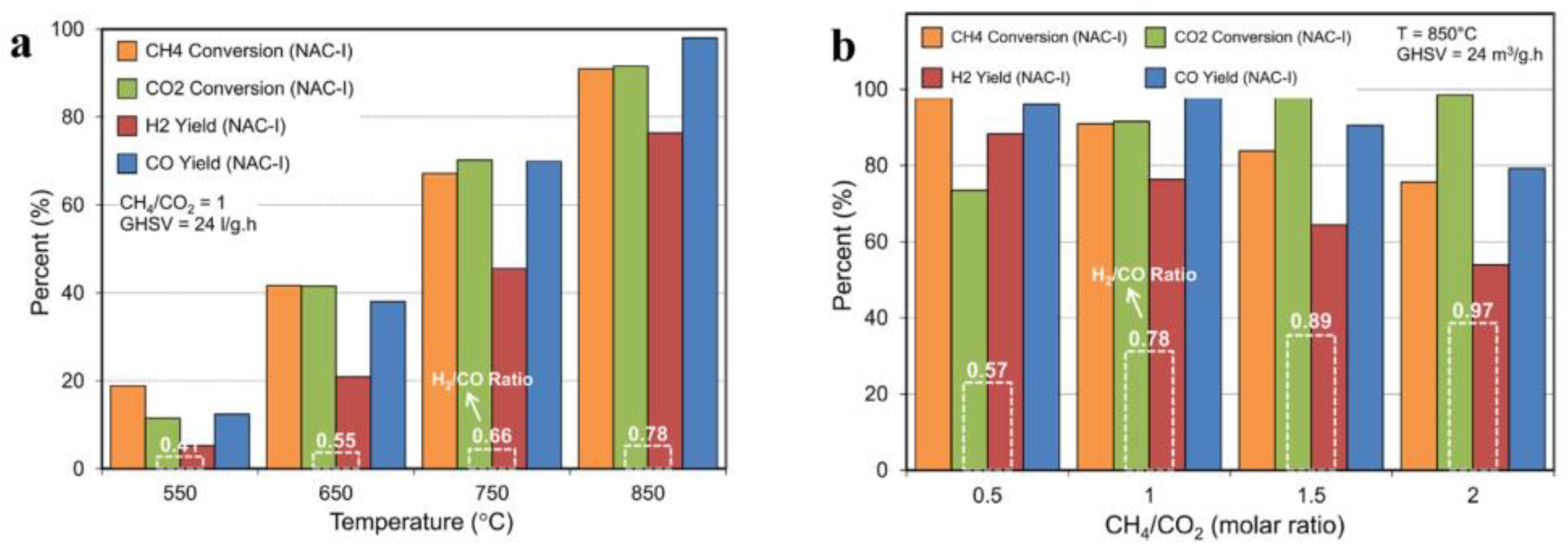
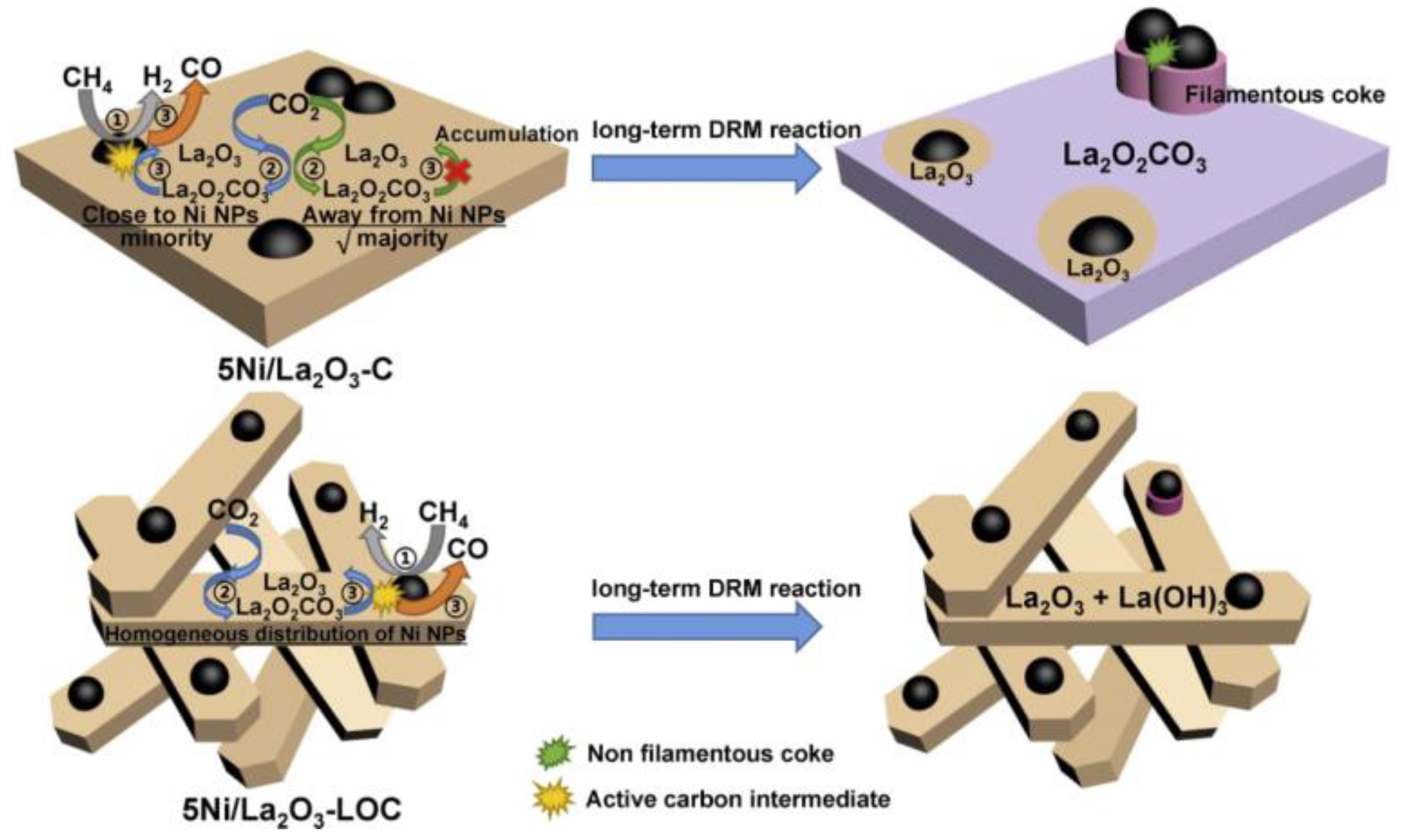
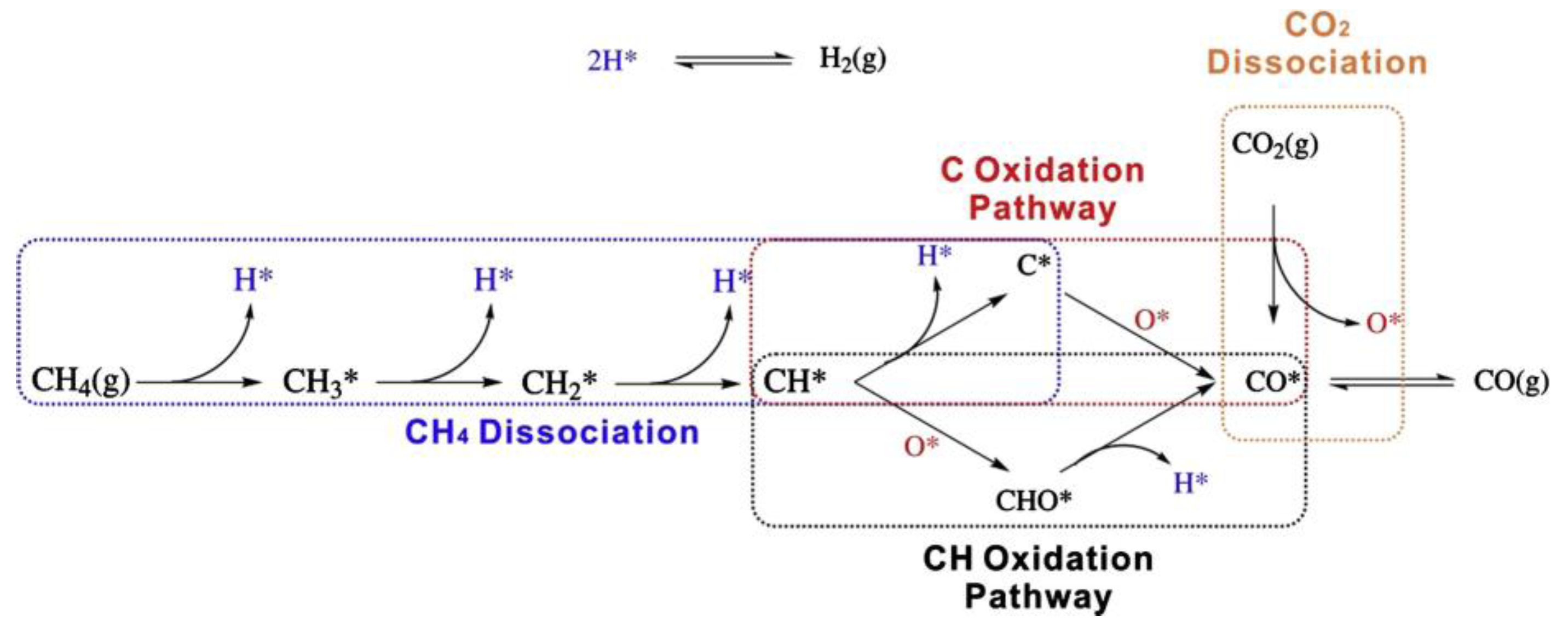

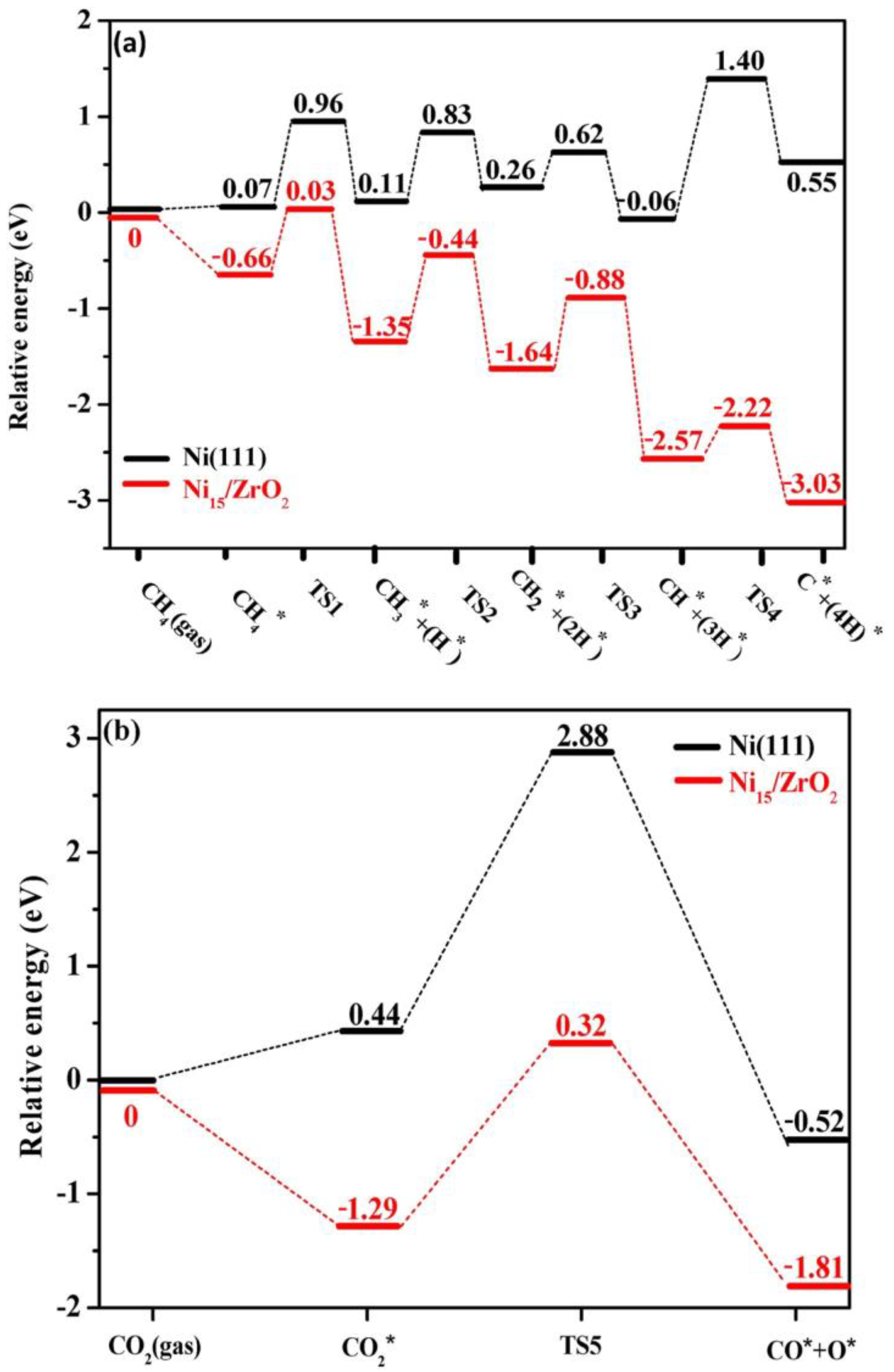

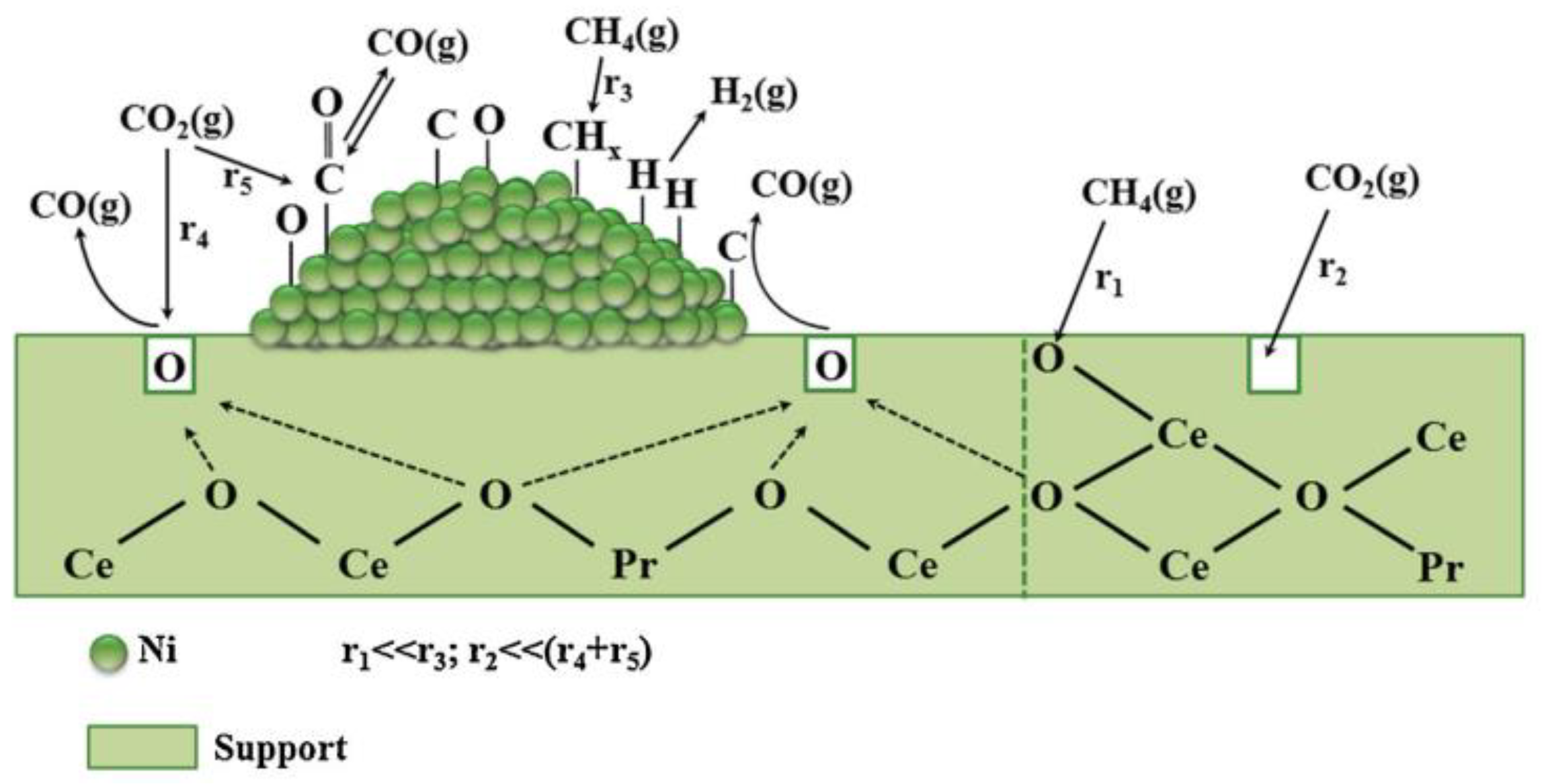
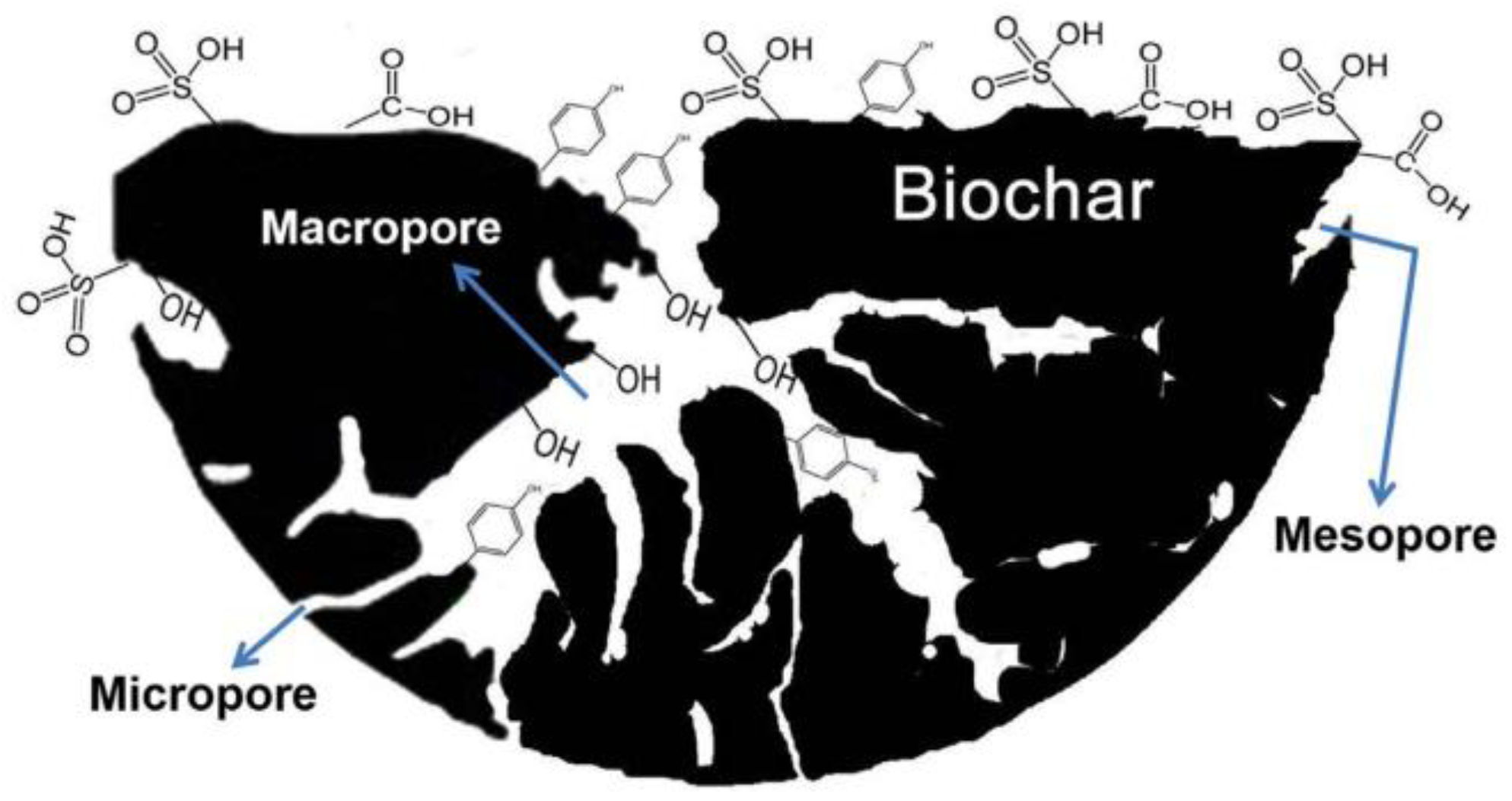


| Reactive Metal | Support | Preparation Method | wNi /% | T /°C | /% | /% |
|---|---|---|---|---|---|---|
| Ni | Al2O3 | Impregnation method | - | 850 | 93 | 96 |
| Ni | La2O3-MgAl2O4 | The modified wet-impregnation method | 10 | 350 | 86 | 84.5 |
| Ni | MgO | Microemulsion synthesis | 80 | 750 | 59.2 | 65.6 |
| Ni | CeO | The wet impregnation method | 8.8 | 800 | 95 | 99 |
| Ni | Pal | The wet impregnation method | 8 | 700 | 99 | 90 |
| Reactive Metal | Support | Additive | wadditive /% | wNi /% | T /°C | /% | /% |
|---|---|---|---|---|---|---|---|
| Ni | MgAl2O4 | K | 3 | 5 | 650 | - | - |
| Ni | Al2O3 | MgO | 3 | 5 | 700 | - | - |
| Ni | SBA-15 | Sc | 0.5 | 5 | 750 | 78 | 86 |
| Ni | γ-Al2O3 | Ru | 0.5 | 10 | 800 | 78 | - |
| Ni | MA | Pd | 0.5 | 6 | 750 | 86 | 92 |
| Ni | CeO2 | Ag | 3 | 10 | 760 | 82.82 | - |
| Ni | Al2O3 | ZrO2 | 1.3 | 4.7 | 800 | 91.3 | - |
| Ni | MgO | Zr | 3 | 13 | 750 | 78 | 91 |
| Reactive Metal | Preparation Method | wNi /% | T /°C | /% | /% |
|---|---|---|---|---|---|
| Ni-Co | The incipient wetness impregnation | 15 | 600 | - | - |
| Ni-Co | - | 10 | 800 | 73 | 82 |
| Ni-Fe | EISA | 5 | 700 | 76.8 | 85.6 |
| Gd-Ni | The wet impregnation method | - | 750 | 85 | - |
| Ni-In | “Two-solvent” method | - | 700 | 91.1 | 97.1 |
| Catalyst | Preparation Method | wNi /% | T /°C | /% | /% |
|---|---|---|---|---|---|
| Ni/Al2O3 | Alkali-induced adsorption | 2.5 | 700 | 59 | 70 |
| Ni/SiO2 | The ammonia evaporation method | 10 | 750 | 80.1 | 89.4 |
| Ni-Al2O3 | EISA | 12 | 800 | 90 | 92 |
| Ni/SBA-15 | Homogeneous precipitation method | 5.47 | 700 | 73.8 | 80 |
Disclaimer/Publisher’s Note: The statements, opinions and data contained in all publications are solely those of the individual author(s) and contributor(s) and not of MDPI and/or the editor(s). MDPI and/or the editor(s) disclaim responsibility for any injury to people or property resulting from any ideas, methods, instructions or products referred to in the content. |
© 2023 by the authors. Licensee MDPI, Basel, Switzerland. This article is an open access article distributed under the terms and conditions of the Creative Commons Attribution (CC BY) license (https://creativecommons.org/licenses/by/4.0/).
Share and Cite
Cai, Y.; Zhang, Y.; Zhang, X.; Wang, Y.; Zhao, Y.; Li, G.; Zhang, G. Recent Advances in Ni-Based Catalysts for CH4-CO2 Reforming (2013–2023). Atmosphere 2023, 14, 1323. https://doi.org/10.3390/atmos14091323
Cai Y, Zhang Y, Zhang X, Wang Y, Zhao Y, Li G, Zhang G. Recent Advances in Ni-Based Catalysts for CH4-CO2 Reforming (2013–2023). Atmosphere. 2023; 14(9):1323. https://doi.org/10.3390/atmos14091323
Chicago/Turabian StyleCai, Yajing, Yunfei Zhang, Xiaodi Zhang, Ying Wang, Yuqiong Zhao, Guoqiang Li, and Guojie Zhang. 2023. "Recent Advances in Ni-Based Catalysts for CH4-CO2 Reforming (2013–2023)" Atmosphere 14, no. 9: 1323. https://doi.org/10.3390/atmos14091323
APA StyleCai, Y., Zhang, Y., Zhang, X., Wang, Y., Zhao, Y., Li, G., & Zhang, G. (2023). Recent Advances in Ni-Based Catalysts for CH4-CO2 Reforming (2013–2023). Atmosphere, 14(9), 1323. https://doi.org/10.3390/atmos14091323






